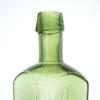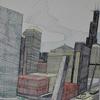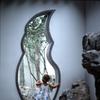In the Style of... a brief look into Karl Springer's designs
- February 02, 2015 17:03
It's a lamp. A tessellated bone lamp. With the original finial. Okay, now what? Well, now we take a look at one of the most sought after (and imitated) designers of recent memory - Karl Springer. Born in Berlin in 1931 he came to America in the late 1950's with dreams of becoming a famous bookbinder. After gaining a position at Lord and Taylor's his work, and pursuit of quality, was quickly recognized. His hand crafted leather and exotic skin smalls soon caught the eye of a buyer for Bergdorf Goodman and became all the rage (it certainly didn't hurt that the Duchess of Windsor also discovered his fine work...) Mr. Springer was soon at the head of his own company, producing furniture in a variety of exotic skins, like shagreen - which he helped to bring back into favor, lacquered parchment, metals, bone, faux finishes, veneers and so on. His workmanship was top notch and he constantly sought out new design inspirations - whether from masters like Ruhlman and Frank, or movements like Bauhaus, or peoples like the Ashanti - Karl Springer had an eye to the past and another firmly on the future. And now we come back to the table lamp aforementioned in this post. Hmmm, Karl Springer style or maybe Attributed to or perhaps In the style of... Oh, never mind, what I have is a fantastic homage to a great designer, who - thanks to dealers and imitators, will live on. This lamp has thin strips of bone veneered to a cylindrical support, a classic nod to one of Mr. Springer's designs. The slender shape of the veneer creates a long, lithe design for the table lamp giving it wonderful presence. With the original, matching finial also veneered in strips of bone - it is a complete look. But Mr. Springer was not the first to create this look... bone, or ivory covered furniture has been with us since the Greek and Roman times. The ivory covering was reserved for the wealthiest of society. Some examples of their furniture have been preserved because of the eruption of Vesuvius in 79 AD which carbonized some of the furniture, thereby saving it for view until today. The Assyrians were also well versed in the use of ivory to decorate their furniture. The Egyptians, too, decorated their furniture with ivory and examples of it can be found in the British Museum. An interesting note across all cultures is that the ivory that was used on the legs and arms of the furniture often terminated in hoofs and heads of animals. These examples have us travelling back thousands of years. Throughout the Middle Ages and into the Renaissance, one can see examples of bone and ivory covered or inlaid furniture across Europe in Italy, France, Spain, etc and in the East. The Chinese also used ivory extensively in their furniture. And the Anglo-Indian furniture that is still copied to this day is not to be left out. This furniture was inlaid with ivory and bone as well as carved from ivory. The Arab countries too had a version of ivory and bone furniture which is not to be overlooked. The introduction of ivory and bone into and onto furniture and furnishings is a time old tradition. Mr. Springer certainly gave this tradition a revival and added his own view onto it. By totally covering the surface of furniture and furnishings in bone, and of course goat skin, parchment, shagreen, etc, Mr. Springer created a bold new look that borrowed from ancient history and made it modern.





















